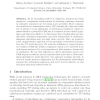Free Online Productivity Tools
i2Speak
i2Symbol
i2OCR
iTex2Img
iWeb2Print
iWeb2Shot
i2Type
iPdf2Split
iPdf2Merge
i2Bopomofo
i2Arabic
i2Style
i2Image
i2PDF
iLatex2Rtf
Sci2ools
RECOMB
2008
Springer
2008
Springer
A Fast, Alignment-Free, Conservation-Based Method for Transcription Factor Binding Site Discovery
As an increasing number of eukaryotic genomes are being sequenced, comparative studies aimed at detecting regulatory elements in intergenic sequences are becoming more prevalent. Most comparative methods for transcription factor (TF) binding site discovery make use of global or local alignments of orthologous regulatory regions to assess whether a particular DNA site is conserved across related organisms, and thus more likely to be functional. Since binding sites are usually short, sometimes degenerate, and often independent of orientation, alignment algorithms may not align them correctly. Here, we present a novel, alignment-free approach for incorporating conservation information into TF motif discovery. We relax the definition of conserved sites: we consider a DNA site within a regulatory region to be conserved in an orthologous sequence if it occurs anywhere in that sequence, irrespective of orientation. We use this definition to derive informative priors over DNA sequence position...
Computational Biology | Gibbs Sampling Algorithm | Most Comparative Methods | Real Biological Data | RECOMB 2008 |
| Added | 03 Dec 2009 |
| Updated | 03 Dec 2009 |
| Type | Conference |
| Year | 2008 |
| Where | RECOMB |
| Authors | Raluca Gordân, Leelavati Narlikar, Alexander J. Hartemink |
Comments (0)

